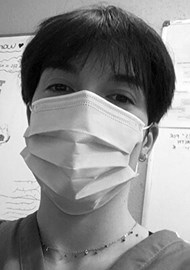
Staring through the fragmented stained glass of the Virgin Mary and her assorted angels, I reflected on the strangeness of the workplace I now found myself working in and the irony of a workforce now working together more enthusiastically than ever before.
The general surgery consultant had excitedly led me and the registrar into the chapel, eager to share his knowledge of hidden nooks in the hospital, before leading us to the canteen for a post-ward round sausage roll and coffee.
None of this may seem out of the ordinary, but before COVID-19 hit it was rare to share more than a few words with the consultant outside of a ward round. The last few weeks had seen the normal hierarchy of medicine disappear as fast as toilet roll from Tesco’s shelves. General surgical consultants were now taking notes during general medicine ward rounds, orthopaedic registrars found themselves looking after more coughs and colds than smashed bones and urology STs were mostly hoping that someone might have a difficult catheter, in fear of redeployment.

Maya Dhillon
With elective surgeries and clinics cancelled, every member of staff in the hospital was suddenly faced with a very different way of working, and specialities were planning and co-operating like never before in preparation for the steep curve of COVID-19 we’d been struggling to flatten.
Hospital-wide meetings, PPE donning and doffing sessions and fit testing of masks had created an Armageddon style atmosphere, with everyone ready to put in the required hours and consultants rushing off to buy camp beds for their offices in preparation for the all-nighters we would soon be faced with.
As an FY2 on urology, I was probably one of the first to be redeployed to the ‘front lines’ or what was now an unrecognisable general surgery department. Two of the wards were now designated for COVID-19 patients, irrespective of whether they had a surgical problem; surgical admissions had been engulfed by medicine and the designated non-COVID-19 surgical high dependency unit (HDU) had a total of two patients…one of whom had COVID-19.
As part of a newly designed rota, we were split into three teams: emergency, elective and off / self-isolate, in anticipation of when most of us inevitably contracted the virus. My first week of the rota was the ‘off’ portion, and so I dutifully stayed at home, joining in the Thursday claps from our flat window and taking advantage of the free Ubereats deliveries on offer, feeling a tad guilty at every mention of overworked front-line staff and NHS heroes putting their lives on the line.
Second week arrived and I found myself in scrubs and surgical mask on the palliative COVID-19 ward. Every morning I accompanied the gastroenterology consultant on the ward round, filling in COVID-19 daily review sheets, DNA-CPRs and treatment escalation plans (TEPs), where you circled whether a patient would be for ward level, CPAP/HDU or ITU level care.
We’re used to ward rounds where we see patients, communicate, share a smile or a joke. These rounds were different: only one member of the team entered the side room or bay, thereby minimising the risk of transmission, and we are left holding a name and age on a sheet of paper to help us picture the person behind the door. Plans often centred purely around comfort care for these patients, from fit and independent 70-year-olds to co-morbid nursing home residents, oxygen saturations dropping at similarly rapid rates, and equally unresponsive to oxygen therapy.
Most days my main task would be calling families to discuss how resuscitation and intubation wouldn’t be an option for their partner / parent / sibling / cousin. A lot of the time these conversations had been anticipated and families were understanding of the limitations of such treatments, but it becomes infinitely harder to outline ceilings of care with families of those previously fit individuals who just the previous week had been visiting grandkids and popping to the shops. Hardest of all was the phone calls to loved ones when the last hours of life inevitably rolled around. No junior doctor is a stranger to death and dying, but we are unused to seeing so many patients die alone behind closed doors. An hour of time is what we can offer one member of family to spend with the dying, a plastic barrier of mask, gloves and apron preventing any warm touch. One daughter had only wish, that someone be holding her mum’s hand when she passed, unable to visit and put her remaining elderly relatives at risk.
In these times of isolation, barriers and distance, I am so grateful that we continue to strive to find new ways of working and caring for one another. From the palliative doctors offering a 24-hour service, to the scrub nurses joining the ITU ranks, to the surgeons signing up to join the medical teams…two metres apart doesn’t seem so far when we’re working closer than ever.
COMMENTS ARE WELCOME









